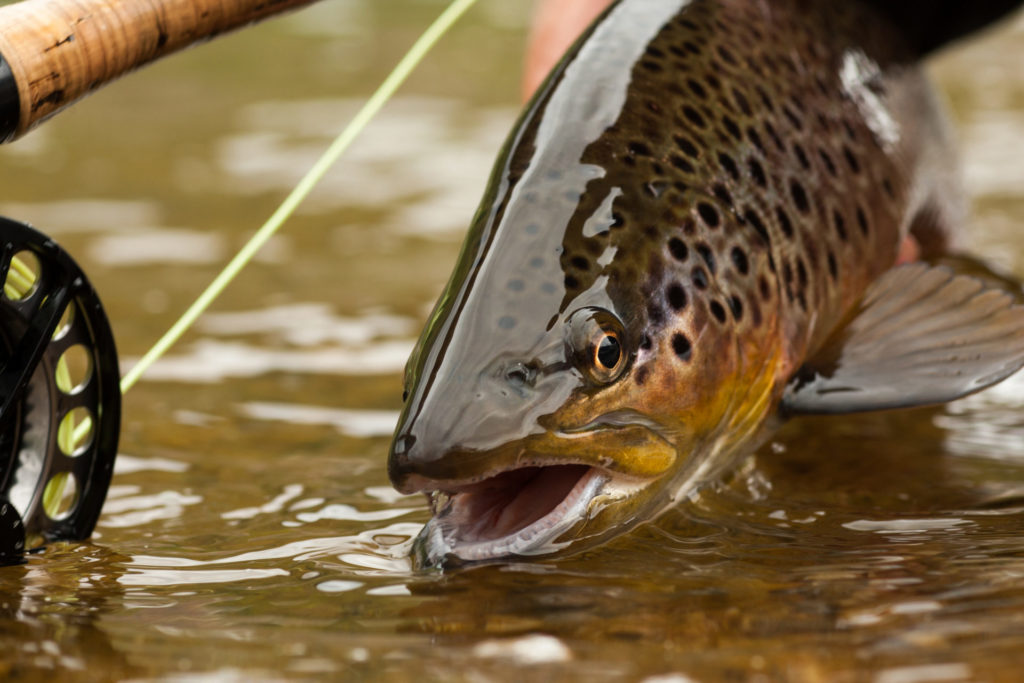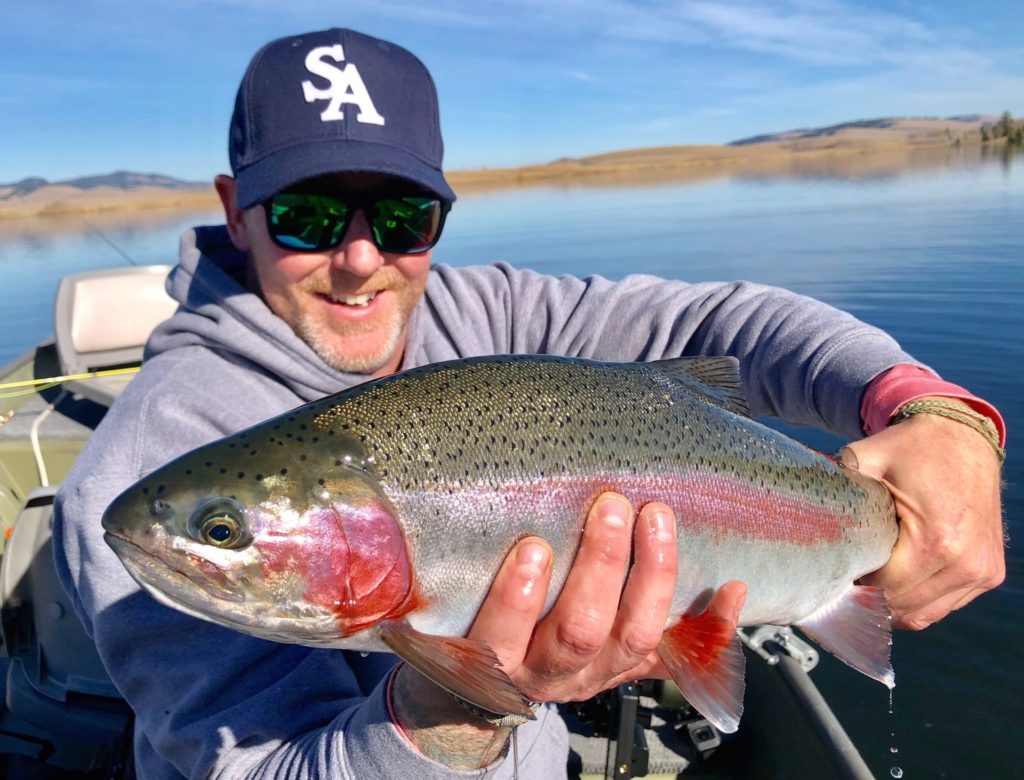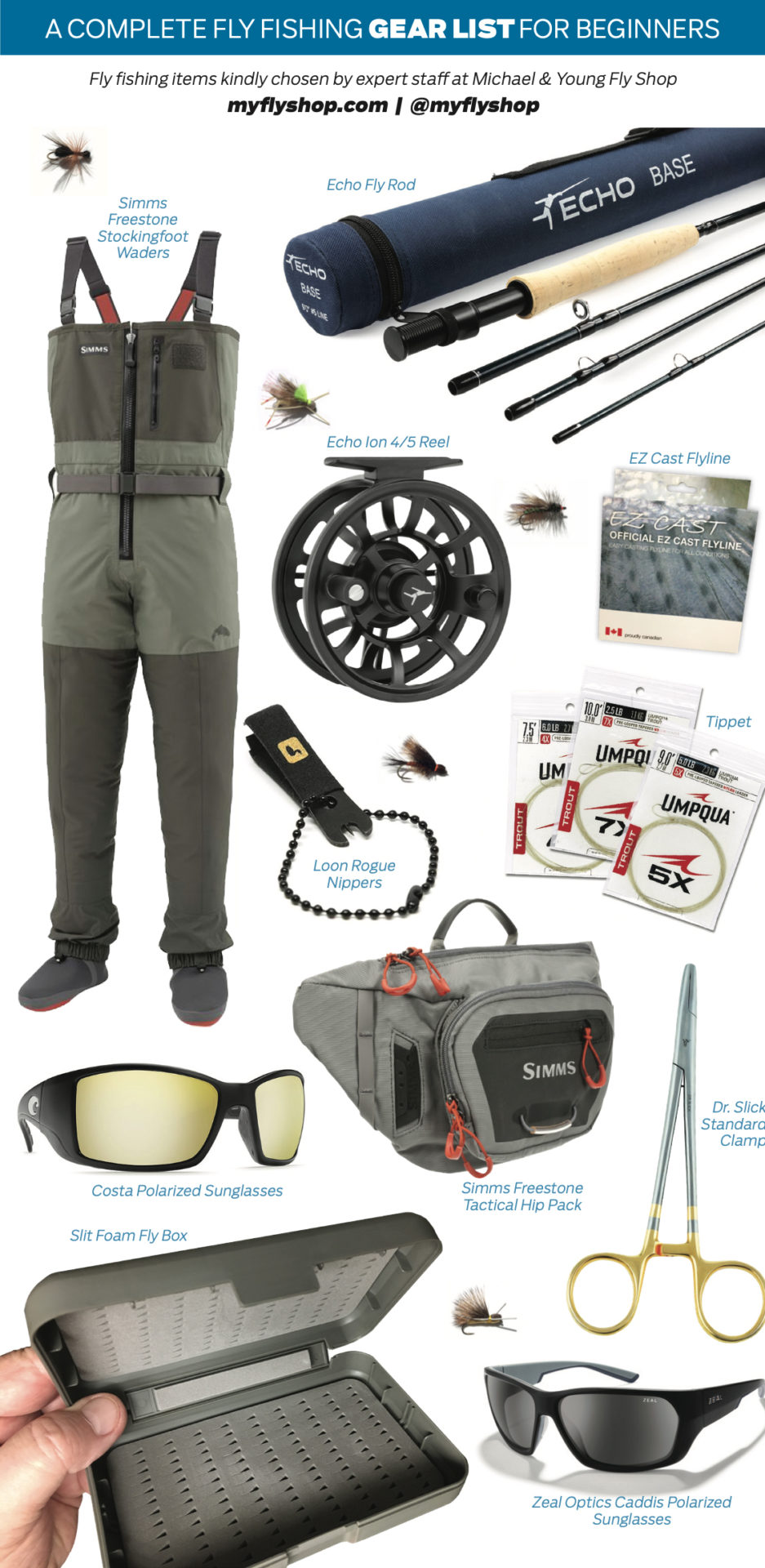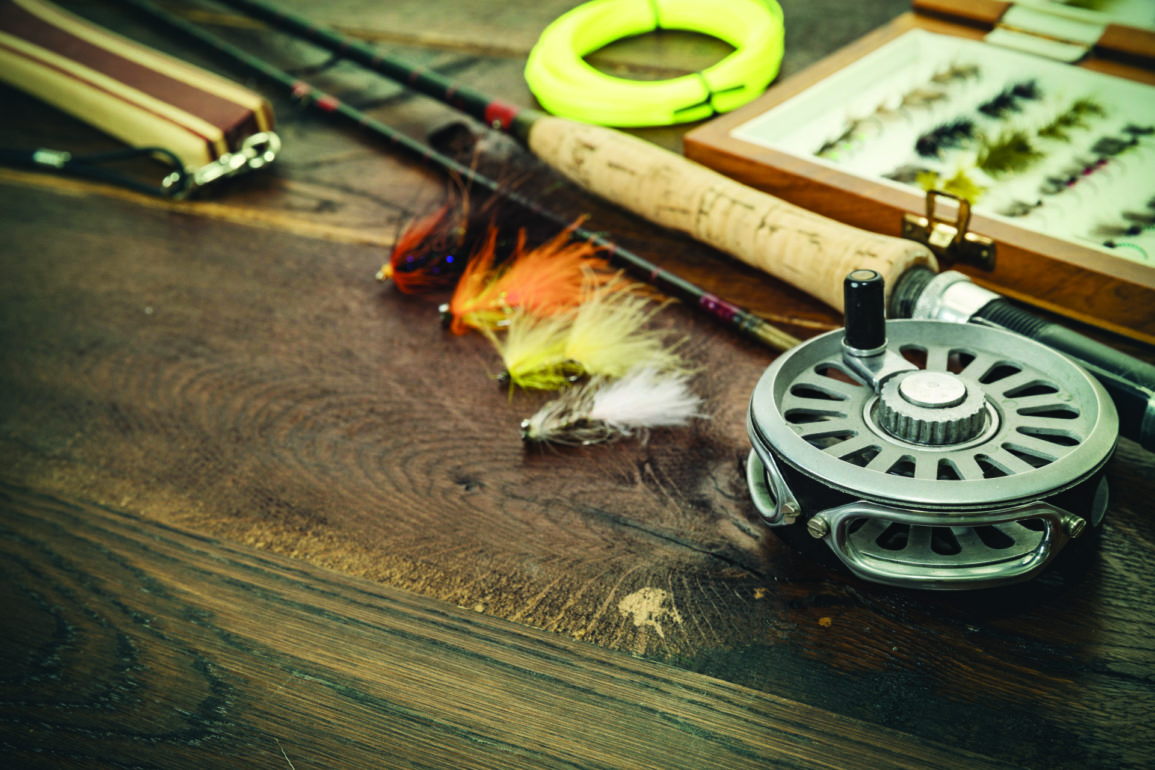For many years at our fly shop and also out on the water when I was guiding, conversations and lessons with beginners interested in fly fishing were a regular occurrence. Maybe strange or maybe somewhat recognizable, I always referred to playing the guitar as a similar reference to fly fishing. For a few obvious reasons, I guess. First and foremost, both a well-practiced guitar player and a well-seasoned fly fisher are really enjoyable to watch. Both are created with good timing, rhythm and, most importantly, practice. Most fly fishers will tell you that the first few times they had a fly rod setup in their hands it wasn’t a pretty thing, and this is definitely the same with guitars.
Advertisement
The journey of beginner fly fishing usually comes from the desire to advance from spinning or bait casting equipment. It’s almost treated as the next step up from regular casting equipment. Some people had a chance to watch someone at a local pond or river presenting beautiful loops of coloured lines flying through the air and that was enough for them to inquire about this hobby. Either way, just like picking up a guitar for the first time, it all comes quickly to those who want the end result.
I will start out with equipment in this article, as this is the first part of the equation that can be slightly intimidating. The latest and greatest of fly-fishing equipment have evolved so quickly that I will keep it to the basics in this article. Just like picking up a new guitar, a decent and well-functioning setup with a protective case is a smart approach and not too expensive.
Advertisement

Fly rods
A perfect starting point for a fly rod, in my opinion, is a setup (or combo) that is geared to fish under the 10-pound mark. By no means does this mean that a fish greater than 10 pounds cannot be landed, it’s just a classification of equipment. Let’s start with a basic fly rod for trout and panfish. The reason I recommend this is that most of the easiest-to-access and readily available waters have these fish in BC, through the longest season of the year. Folks in the Lower Mainland and on Vancouver Island can almost fish for these species 12 months of the year. The two major classifications in BC for fly rods are trout and panfish or salmon and steelhead. There’s quite a noticeable size, strength and weight difference between the two genres of this fly equipment.
There are two important numbers to look for and recognize when seeking out your first fly rod. 1) length, and 2) the rod weight (#). An important thing to note is the rod weight is a class number, it’s not the actual weight of the rod. On the section just above the cork handle, somewhere near the brand name of the rod, will be a description reading its length and rod # (rod/line weight). Don’t get discouraged here, it’s normally written with entry-level rods as, for example, 9 foot #6. This means nine feet in length and a rod weight of six. Why I used this for an example is that I believe this is the perfect length and rod weight for someone to begin casting and learning on. By no means does this mean if you were given a nine-foot, six-inch #7 fly rod that it’s not the best to start on, I’m just recommending what the industry has stated as a standard setup. Much like a six-string acoustic guitar!
Advertisement
Rods come in all colours and creative finishes. Important factors for beginners boil down to a good cork handle, a reasonable price and some sort of transportation case and or sock. The majority of broken rods occur during transport. If they do break fighting fish, the odds were that the damage happened in transport or storage before the fish hit. I always suggest being ready to spend around $100 on your first rod. Combos are also an important consideration, rod reels and line, which will cost somewhere between $150 and $250 for good, stable equipment to get you started. Of course, these numbers climb quickly and spending more money will add things like better warranties, overall weight, design and build quality, packing cases and so on. Don’t be discouraged, set your budget ahead of time and set your goals on catching fish.

Fly reels
An important and sometimes shocking truth to regular trout and panfish setups is how irrelevant the cool-looking reel plays out in the actual equation. As many have said before me, its sole purpose is that of a line holder. Reels will generally have a few numbers on the back that are similar to the rods they’re designed to be on for size and capacity. A matched fly reel for a #6 fly rod will say something like 56 or 67 or 6000, etc. Generally, they will be the size of the lid of a soup can, if that helps out. Impressive drag features, anodized components and slick finishes are all for those really seeking exotic destinations to catch supercharged fish, but nonetheless, they will look and feel better when showing your friends. Good conditioned, working reels on their own will run you from $60 and up. The first part of the fly line installation is called backing. This is the underlay of thin dacron or braided synthetics that provide 150-plus yards of extra line underneath your fly line. This not only adds reserve line to your 100-foot fly line if a big fish takes off, it’s also used as a levelling system to get your reel as full as possible. A reel that’s spooled close to capacity has a much faster line pick up. Again, looking for a rod and reel combo or kit already put together by a shop or manufacturer can add great savings and eliminate some of the steps just described.
Fly lines
Oh yes, fly lines. This is where things can get complicated going in fairly new to this hobby. I will be very honest and to the point with fly lines here. This part of the equation is just as important, if not more so, than the rod in certain equations. The line performs the action that your hand has told the rod to do. They are shaped in accordance to their weight (line weight/line #) and need to follow that matching sequence. The first thing that new fly fishers note is how many lines are on the wall of a shop and how many numbers are on each box. This is the part where you stop and take a moment to learn this system. Here it goes. The long sequence begins with letters and then numbers in a line. The first letters are the shape or design of the taper, the second number is the line weight to match to the rod, and the third set of letters and sometimes letters and numbers are the type of line (floating or sinking, etc.) Here is the most common line type to get things started, and I’ll break it down right after for reference: WF6F. OK, WF (weight forward) 6 (6 weight, #6 rod) and finally F (floating line). A second line with the same packaging may read WF5S6. What is that? Well, that’s a weight forward, 5 weight sinking fly line that has a fast sink rate of 6. Don’t be too confused. It all makes sense in time. So what do you do to get a fly line best suited to start out? Here’s what is the safest and most practical. Look for a line that’s weight forward, which is the easiest to cast and load. Buy one that matches your rod weight or number. Buy a floating line to start out. Floating lines are absolutely the best lines to learn on, are the safest to have winging by your face, are the easiest to see and handle and, most importantly, the most versatile to use from surface fishing right down to 20 feet or more of water.
Leaders & tippet
This is the part where the fish start to decide if they like what you’re doing. Leaders are the clear (mono or fluorocarbon) section that separates your fly line from your fly, helps to turn over your fly (presentation) and keeps the fly somewhat invisible near its knot. Tapered leaders are built without knots, come in a handy package and are sold in various lengths and breaking strengths. My best recommendation is to buy one that’s ironically labeled like your rod (9 feet/6 pound). This tapered leader starts with a heavy section called the butt section, which joins to your fly fine as either a loop to loop or with a nail knot. As you run your hand through the leader, you will notice it slowly thins out (tapers) to a 40-inch-plus length of 6 pound, or whatever you have purchased. It’s important to have fairly light leaders at the fly end (this is what we call the tippet) where the fly affixes. Over time, after losing flies or breaking them off on branches, the tippet portion of your leader can become too short and the leader needs to be adjusted. At this point, you can either buy a new tapered leader and reconnect, or you can buy a small roll of tippet material and learn the blood knot or surgeon’s loop to add more length to the end. I always suggest forward thinking, therefore having tippet spools on hand while angling helps keep you able to adjust and control your presentations as the elements or bodies of water change around you.
Flies
Oh my. How can I keep this simple? Well, grab yourself some of the smaller, basic patterns that will get airborne and land safely, to start. There’s literally thousands and thousands of popular patterns that all catch fish. A few good, simple patterns to put in your box would be:
- Universal dry flies: Tom Thumb, Adams
- Basic nymphs: Hare’s Ear, pheasant tail nymph
- Smaller streamers/attractors: Wolly Buggers, Pumpkin Heads, leeches
Pick a few colours and smaller sizes of each to get you started. You can worry about the other thousand patterns soon enough. Another confusing note about flies and actually fly casting is that large or heavier flies are much more difficult to cast, which is the opposite of lures and spinners. The bigger and heavier the fly, the more drag it causes running behind a cast. This in turn creates a disconnect of motion and ends up as a real challenge. Please also note that weighted flies are dangerous to start out with. A weighted fly can take its own path and can end up where it shouldn’t. Of course, removing barbs on flies is a must, always. There are all sorts of fly boxes out there, make sure you grab one, and, more importantly, try not to store your flies in a sealed box while they’re sopping wet.

Important Extras
Without breaking the bank and looking too heavily decorated out there, a few things to keep in mind I’ll list here as fairly important. Number one is sunglasses. We can also call them safety goggles, for obvious reasons. Protect your eyes from hooks flying past your head. One gust of wind mid-fly cast could change your sight forever. I always highly recommend polarized sunglasses, which kill two birds with one stone: protect your eyes and see fish and structure much better. Second is a few tools to keep you fishing effectively. A set of nail clippers for trimming line and knots, as well as small needle-nose pliers or forceps are great to have at all times. Third and final as a basic start up is a packable gear bag. The bonus of fly fishing is realizing how light, and small, most of the equipment is. Some choose small waist packs to start, mini backpacks or even the old, pocket-ridden vests. Either way, making sure you have a few of your important tools with you at all times is a great start to a great hobby. Of course, over time beginners start accumulating more stuff, and even more stuff, and that’s not even touching on the topic of fly tying.
I hope this helps you understand some of the most common things to learn about beginner fly fishing equipment, and shedding some light into the numbers, sizes and weights. We all had to start out somewhere, and it was all foreign equipment to all of us at one time. Ultimately, the best thing to do is go visit your local fly shop and have a look around. There’s nothing more helpful than the guys and gals in these stores. These people eat, drink and breathe for this stuff and you’ll be surprised how helpful it is to hold some of this stuff in your hand, next to a knowledgeable angler. By shopping just online, the disconnect and disappointment factor rises quickly. Go grab some cork and throw a loop or two this winter, you won’t be disappointed.
